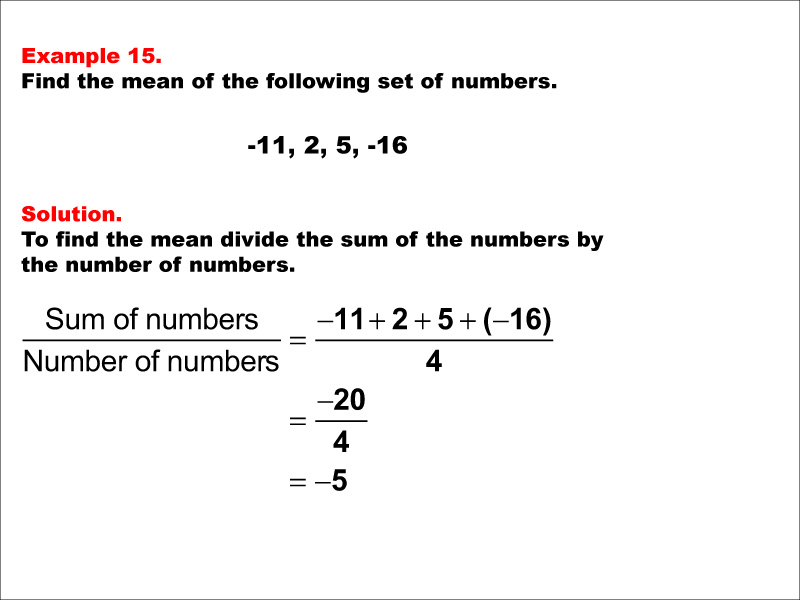
Display Title
Math Example--Measures of Central Tendency--Mean: Example 15
Display Title
Math Example--Measures of Central Tendency--Mean: Example 15

Topic
Measures of Central Tendency
Description
This example illustrates the calculation of the mean for the numbers -11, 2, 5, and -16. The process involves summing all values (-20) and dividing by the count of numbers (4), resulting in a mean of -5. This example is particularly important as it demonstrates how to handle negative numbers when calculating the mean, a concept that often challenges students.
Understanding measures of central tendency, especially the mean, is fundamental in statistics and data analysis. These measures allow us to condense large datasets into single, representative values, facilitating comparisons and providing insights. Mastering these concepts, including working with negative numbers, equips students with the tools to interpret data effectively and make informed decisions across various academic and real-world contexts.
Providing multiple examples, especially those involving negative numbers, is crucial for deepening students' understanding of the mean. Each new example reinforces the calculation process while introducing slight variations in the data, helping students recognize that the concept applies universally, regardless of whether the numbers are positive or negative. This approach builds confidence and prepares students to apply the concept flexibly in various real-world contexts, from analyzing financial data to interpreting scientific measurements.
Teacher Script: "Let's look at our fifteenth example of calculating the mean. Notice that this dataset includes both positive and negative numbers. As we work through this, think about how the presence of negative numbers affects our calculation process. Does the mean being negative (-5) surprise you? Remember, a negative mean simply indicates that the negative values in our dataset outweigh the positive ones. This example shows how the mean can provide valuable information about the overall trend of our data, even when it includes numbers below zero."
For a complete collection of math examples related to Measures of Central Tendency click on this link: Math Examples: Measures of Central Tendency: Mean Collection.
| Common Core Standards | CCSS.MATH.CONTENT.6.SP.B.4, CCSS.MATH.CONTENT.6.SP.A.3, CCSS.MATH.CONTENT.HSS.ID.A.2, CCSS.MATH.CONTENT.HSS.ID.A.3 |
|---|---|
| Grade Range | 6 - 12 |
| Curriculum Nodes |
Algebra • Probability and Data Analysis • Data Analysis |
| Copyright Year | 2014 |
| Keywords | data analysis, tutorials, measures of central tendency, mean, average |